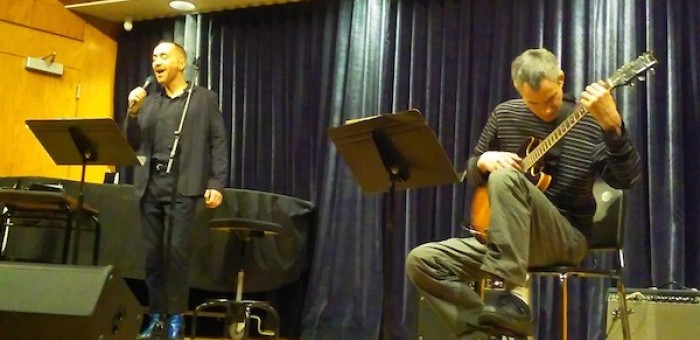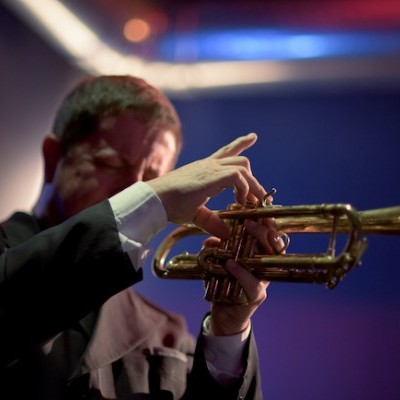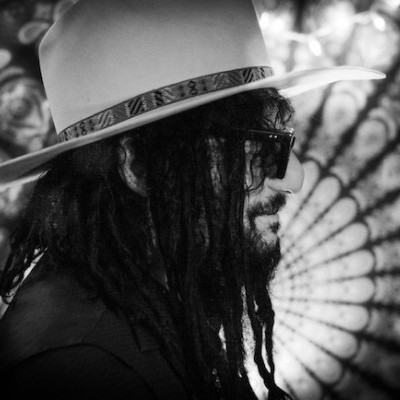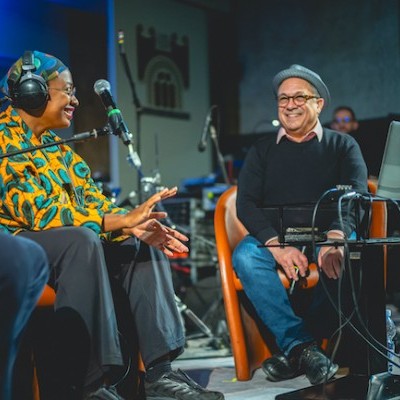Jul 9, 2024 11:35 AM
Trumpeter, Educator Jim Rotondi Dies at 61
Jim Rotondi, a renowned hard-bop trumpeter, composer and educator, died suddenly on July 7 at a hospital in France. He…

Theo Bleckmann (left) and Ben Monder perform at Western Michigan University in Kalamazoo, Michigan, on April 9. (Photo: John Ephland)
(Photo: )Singer Theo Bleckmann and guitarist Ben Monder performed before an intimate audience at Western Michigan University’s Dalton Center Recital Hall in the second of two shows April 9, extending a musical relationship that goes back more than 20 years.
Their set demonstrated a knack for blurring the boundaries of song, reinventing what it means for a singer and guitarist to team up in the 21st century. Using electronic looping and processing to create selective choral and textural effects, Bleckmann had his hands (or voice) full as Monder’s regularly thunderous and full-bodied guitar filled the room.
Not surprisingly, the overall atmosphere was dreamy, with occasional nods to something resembling grunge. Bleckmann’s voice and Monder’s guitar, for those familiar with each artist’s repertoire, seem well suited for each other. That was certainly the case this evening.
Granted, there were rough edges along the way, but jazz, being an improvised music, is sometimes the better for it. More than a few audience members must have been grateful that these New York-based artists came to town to deliver a full-hearted performance—honestly and forthrightly.
On the whole, the music appeared sketchy, despite the presence of music stands. In fact, the stands seemed to be a way into hearing the music visually, the listener perhaps wondering how it all was put together. Bleckmann was riffing, scatting and singing wordless vocals, while Monder’s guitar emitted mashups of eloquence with sheer sonic blasts of controlled feedback. Nonetheless, the guitarist’s fulsome, finger-picking style resulted in soaring lines that gave Bleckmann a large canvas on which to project his artistry. And with crescendos building, there still tended to be melodic lines one could hear streaming through the periodic blazes.
For his part, Bleckmann’s use of electronics and tape loops at times sounded orchestral, creating angelic unison lines with the guitarist. By and large, the music sidestepped meter, opting for more floating pulses that suggested a natural heartbeat, even if it was an irregular one.
The performance was also marked by shifts in intensity. There were moments when Monder was literally pulling his strings off the body of his electric guitar, hands flying. Elsewhere, Bleckmann would tilt his face skyward and sing a serene note with eyes closed, and Monder, just as calmly, letting his guitar softly grind.
It was during these rare episodes that one might reconsider these artists’ collective and individual relationships to the jazz canon, and the amount of research each has done on all manner of musical forms, including pop and classical, and how it all informs their work together. One could enjoy knowing that some of these pieces were commissioned by the Dance Center of New York City.
In the end, the duo’s reaching, albeit uneven performance resulted in the creation of an enveloping, sometimes luminous world. An intimate musical conversation, this spacious musical dialog was, paradoxically, full of content, with voices folding into each other in unsuspecting ways.
Their mostly modal set climaxed with more reverb as the duo suddenly turned up the heat, the two becoming unmoored, musically darting to and fro. Finally centering around a pulse (3/4) with lyrics (including the Beatles’ “Norwegian Wood”), Bleckmann and Monder’s freewheeling crescendos of alarming frenzy ended in, of all things, a major key!
(Note: To read a review of Theo Bleckmann’s performance at the 2016 Winter Jazzfest, click here.)
—John Ephland

Jim Rotondi was acclaimed for his wide, round trumpet tone, remarkable virtuosity and assured swing.
Jul 9, 2024 11:35 AM
Jim Rotondi, a renowned hard-bop trumpeter, composer and educator, died suddenly on July 7 at a hospital in France. He…

Charles Lloyd, seen here at the 2024 New Orleans Jazz & Heritage Festival, makes DownBeat Poll history!
Jul 11, 2024 12:23 PM
The incomparable Charles Lloyd swept the 72nd Annual DownBeat Critics Poll, becoming the first artist ever to earn…

“Being president of Blue Note has been one of the coolest things that ever happened to me,” Was said. “It’s a gas to serve as one of the caretakers of that legacy.”
Jun 4, 2024 12:21 PM
Sitting with Don Was is a comfortable and unhurried exercise. He may seem slightly reserved at first, but ideas and…

“She reminds me of my childhood and makes we want to cry,” Cécile McLorin Salvant, pictured here with writer Ashley Kahn, said of Dianne Reeves.
Jun 11, 2024 12:31 PM
Italy’s Umbria Jazz Winter is one of those rare annual festivals that not only coincides with a major holiday —…

Maria Schneider said of Decades, her new compilation release: “I just wanted to create something, put it in a beautiful box and say, ‘Look at what we did.‘”
Jun 18, 2024 12:00 PM
Maria Schneider opened the sleek black box and placed it on a coffee table in her Manhattan apartment. Inside lay the…